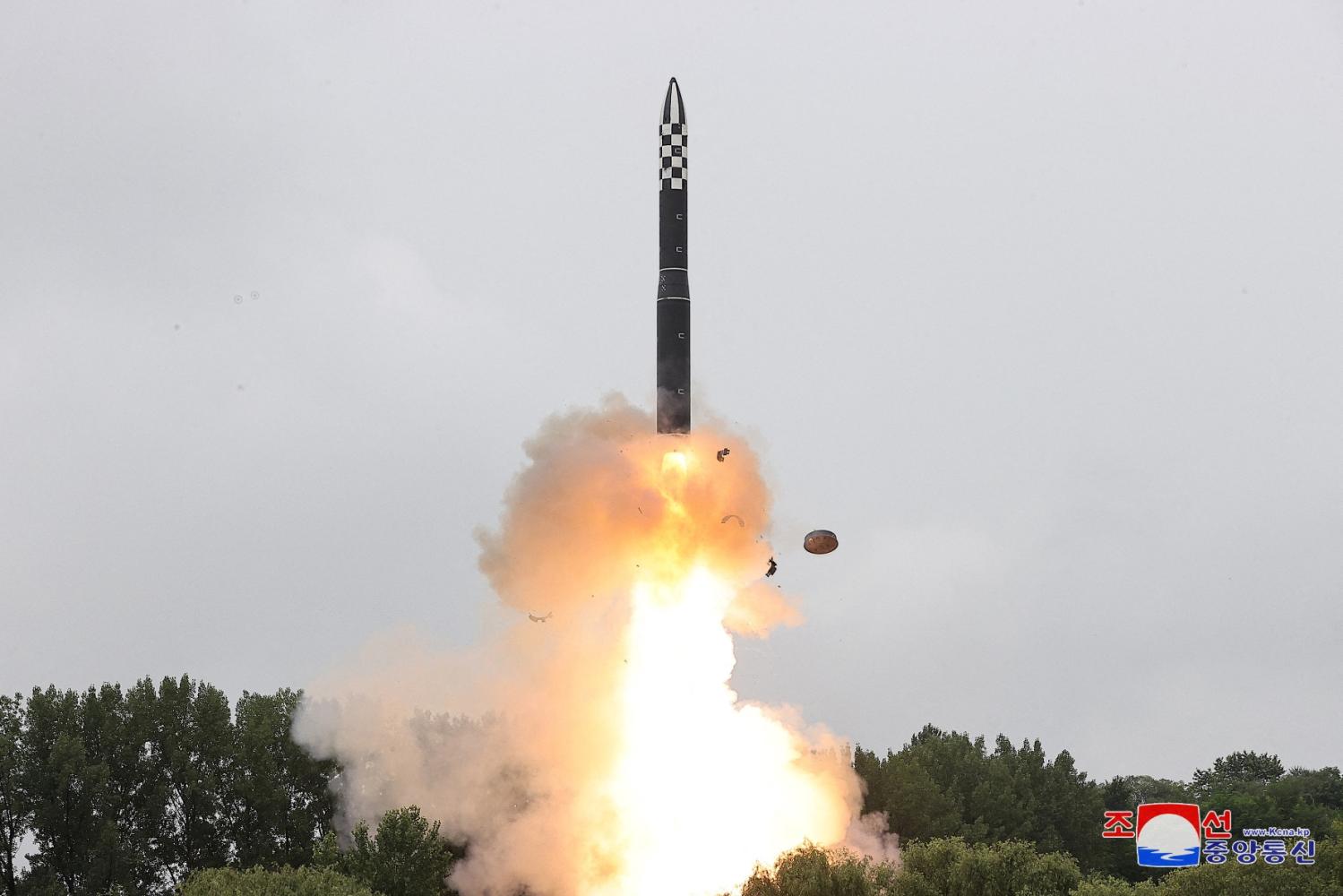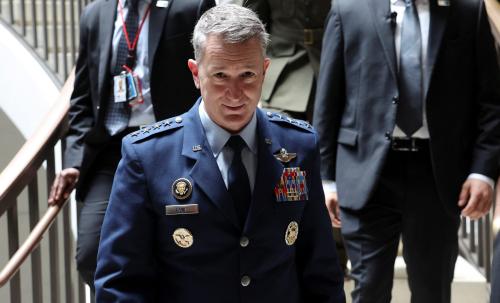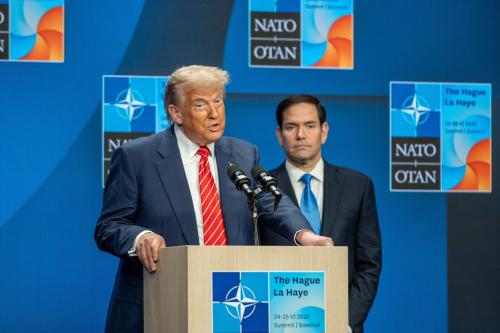The following is a slightly revised presentation given remotely by Robert Einhorn on October 6, 2023, to the 2023 Kim Dae-jung Peace Forum, held October 4-6 in Mokpo, South Korea.
At this Kim Dae-jung Peace Forum, it’s useful to recall seemingly paradoxical advice offered by a fourth-century Roman general: Si vis pacem, para bellum. “If you want peace, prepare for war.”
This Roman-era aphorism has come to mean that if you face an aggressive adversary, build your military strength so that the adversary knows that, if it launches an attack, it will receive a punishing response — and will therefore be discouraged from pursuing such an attack. The idea of achieving peace by preparing for war has been a critical foundation of security strategies for many centuries. Today we call it “deterrence.”
Of course, not all countries prepare for war in order to have peace. Some have prepared for war as a prelude to waging war. Hitler built the Nazi war machine to conquer Europe and beyond. But for countries genuinely seeking peace and facing significant security threats from well-armed adversaries, building countervailing military strength has usually been the chosen strategy. They feared that failure to build and maintain adequate deterrent capabilities would signal weakness and might only invite aggression.
Deterrence — or peace through strength, as it is sometimes called — has stood the test of time because it is widely believed to have worked. Deterrence of the Soviet Union by the United States and its NATO allies during the Cold War is credited with avoiding a major East-West conflict.
But a strategy of deterrence is not without risks. Strengthening defenses to deter an adversary may be interpreted by that adversary as an indication of aggressive intent and a serious threat to its own security. It may respond by further building up its own capabilities. The result may be an expensive and destabilizing arms race — one that reinforces mutual antagonisms, perpetuates a state of confrontation, and makes resolution of the underlying conflict even more difficult.
In addition, as both sides build up their military capabilities, they may declare policies, test weapon systems, or engage in exercises or deployments that the other side views as preparations for the use of force, even preemptive use of nuclear weapons. In such an environment, the risk of armed conflict breaking out as a result of accidents, misperceptions, or miscalculations would grow.
Moreover, even if a mutual military buildup does not result in large-scale armed hostilities, it would not necessarily prevent lower-level provocations. Indeed, an aggressor’s belief that it could deter large-scale retaliation could increase its confidence that it could engage in lower-level provocations with impunity.
To avoid war and ultimately achieve peace, deterrence should be accompanied by diplomacy.
During the Cold War, while amassing huge nuclear arsenals to deter each other, the United States and the Soviet Union engaged in diplomacy to moderate and stabilize their competition, limit and reduce their nuclear forces, adopt transparency and confidence-building measures to avoid dangerous miscalculations, and in general prevent their competition from getting out of control.
Yes, if you want peace, prepare for war. But also pursue diplomacy.
So, how do these considerations apply to matters of war and peace on the contemporary Korean Peninsula?
North Korea’s growing capabilities
Seventy years after the Korean Armistice Agreement, hope for genuine peace on the peninsula continues to fade. In recent years, the security environment has dramatically deteriorated. The primary cause of increased tension and instability has been North Korea’s relentless efforts to expand and diversify its nuclear and missile capabilities.
Under Kim Jong Un, this rapidly growing nuclear arsenal has been accompanied by inflammatory rhetoric toward Seoul and Washington, including the North’s often-declared willingness to use nuclear weapons preemptively.
What is Kim’s motivation for his aggressive nuclear posture? Is it essentially defensive — to ensure the survival of his regime from foreign interference or attack? Or is it essentially offensive — to intimidate and coerce South Korea and reunify the peninsula under Pyongyang’s control? Of course, we don’t know. We can only speculate.
North Korea’s initial motivation for pursuing nuclear weapons may well have been defensive — to deter what it perceived as foreign, mainly U.S., efforts to undermine or eliminate its regime. But whatever its initial motivation, Kim may now feel emboldened by his increased capabilities to pursue more offensive objectives.
Most observers doubt that Kim sees reunification of the peninsula by force as a realistic possibility. But he may now feel he can dominate inter-Korean relations, drive wedges in the U.S.-South Korean alliance, and engage in increasingly aggressive provocations. And he may become dangerously overconfident in his ability to control the risks of escalation.
South Korea and the United States have become increasingly alarmed by the growing threat from North Korea. South Korean concerns have been magnified by uncertainty about the reliability of U.S. security guarantees.
U.S.-South Korean response: Prioritizing deterrence
The main allied response to the North Korean threat has been to boost their collective deterrent capabilities.
At the highest political levels, the administrations of President Yoon Suk Yeol and President Joe Biden have worked together closely to demonstrate strong alliance solidarity and resolve. Seoul has augmented its own conventional capabilities, including its three-axis strategy. South Korea and the United States have taken significant steps to reinforce the credibility of the U.S. extended nuclear deterrent and to give South Korea a more prominent role in the planning and execution of that deterrent — most notably in the Washington Declaration adopted during Yoon’s state visit to Washington in April. And together with Japan, the allies have boosted trilateral defense cooperation in unprecedented ways, as agreed at the recent Camp David summit.
While prioritizing deterrence, the allies have also sought diplomatic engagement — reaching out repeatedly to Pyongyang to begin talks. But all those initiatives were rebuffed by the North.
In the absence of diplomacy, the situation is becoming more dangerous. North Korea continues to advance its threatening capabilities. The allies continue to strengthen their deterrent — with large-scale, live-fire joint defense drills and high-profile visits of U.S. strategic assets, including a port visit by a U.S. ballistic missile submarine. Pyongyang, in turn, condemns those allied efforts, which it claims are preparations for attacking the North. It says those efforts justify the further acceleration of its own programs and even its preemptive nuclear doctrine.
Risk reduction: The most immediate objective
So, what can be done to break this downward spiral? I think it may be time for a renewed push for diplomacy. But to get talks underway, a somewhat different approach may be required.
I believe the major reason Kim Jong Un has so far rejected engagement has been his desire to avoid talks that might interfere with the completion of his ambitious five-year plan to develop and test key nuclear and missile capabilities.
But another reason may be what Washington and Seoul declare must be the focus of any negotiation — namely, the North’s complete denuclearization. Kim has made it clear that he has no intention of eliminating what he regards as essential to the survival of his regime. He says repeatedly that North Korea’s possession of nuclear weapons is irreversible and non-negotiable.
If Pyongyang eventually gets rid of its nuclear weapons, it will be the result of either a fundamental transformation of the current regime’s policies and values or its collapse.
Neither outcome can be dismissed altogether, especially the regime’s eventual collapse. But we can’t count on either one, at least not in the near term. Realistically, we will have to live with North Korea’s possession of nuclear weapons for the foreseeable future.
The United States and its allies can’t accept the North as a legitimate nuclear-armed country. It acquired nuclear weapons illegally and deceitfully. Accepting its nuclear capability would set a dangerous precedent that is damaging to the global nonproliferation regime.
So, the United States and its allies should continue to adhere to the ultimate goal of the complete denuclearization of the Korean Peninsula. But for now, they should focus on the most immediate threat — the risk of intentional or inadvertent armed conflict that could escalate to the nuclear level.
The United States and the South should therefore approach the North and propose setting aside denuclearization for the time being and focusing instead on a risk reduction agenda — primarily confidence-building, transparency, and communications measures that can enhance predictability and reduce the risks of armed conflict resulting from accident, misperception, or miscalculation. Negotiations could take place bilaterally, trilaterally, or in a multilateral regional format, perhaps involving the countries that participated in the Six-Party Talks.
Participants might be required to reaffirm the goal of complete denuclearization of the Korean Peninsula — a goal Kim Jong Un supported in the 2018 Singapore Joint Statement — although participants would presumably continue to differ on the conditions that would make the attainment of that goal possible.
The risk reduction measures that might be considered in such talks could include:
- prenotification of flight tests of several categories of missiles.
- prenotification of land, sea, and air military exercises meeting certain agreed-upon criteria.
- avoidance of military activities in specified geographic areas (for example, no-fly zones or maritime buffer zones).
- the establishment of routine and crisis communications channels.
- the resurrection of several confidence-building steps contained in the moribund North-South Comprehensive Military Agreement.
- the adoption of so-called “rules of the road” to prevent provocative cyber activities.
- the toning down of inflammatory rhetoric (including threats to use nuclear weapons preemptively or to launch decapitation strikes against an adversary’s leadership).
- the creation of what might be called “risk reduction dialogues” where civilian and military officials would meet regularly to raise concerns about another country’s military activities and seek measures to address those concerns.
Such risk reduction measures would not bring peace to the Korean Peninsula. Neither would they ensure progress toward denuclearization or remove the need for current U.S. and South Korean efforts to strengthen deterrence and maintain allied military readiness.
Moreover, North Korea’s willingness to engage on risk reduction measures is far from certain. It may believe that maintaining risks at a high level serves its interests by discouraging the United States and its allies from conducting military activities that could increase the likelihood of conflict. Or it may decide to engage but condition its support for risk reduction measures on unacceptable concessions from the allies.
Still, in light of the huge stakes, it is worth a try. Risk reduction measures along these lines — together with a determined allied effort to reinforce deterrence — could help arrest or even reverse the current downward spiral on the peninsula. They could reduce each side’s incentives for pursuing an open-ended arms competition. Perhaps most importantly, they could help alleviate one of the most acute threats on the peninsula today — the risk of inadvertent armed conflict that could escalate to nuclear war.
And if faithfully implemented, such measures could reduce tensions, build habits of constructive engagement, pave the way for practical steps to reduce the North Korean nuclear threat — and at least keep alive the hope, however remote today, of a nuclear weapons-free Korean Peninsula living in peace.
“If you want peace, prepare for war.” There’s much truth in that age-old advice. Deterrence may well be a necessary condition for achieving peace — or at least avoiding war.
But it’s only a partial truth. Deterrence may be necessary, but it’s not sufficient. It must be accompanied by diplomacy. And there’s an increasingly urgent need for diplomacy on the Korean Peninsula — diplomacy with realistically achievable and critically important goals.
The Brookings Institution is committed to quality, independence, and impact.
We are supported by a diverse array of funders. In line with our values and policies, each Brookings publication represents the sole views of its author(s).




